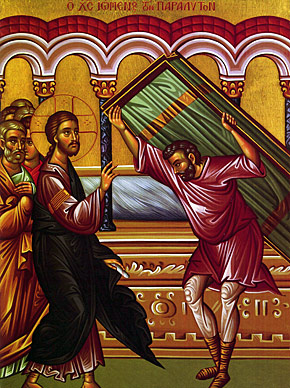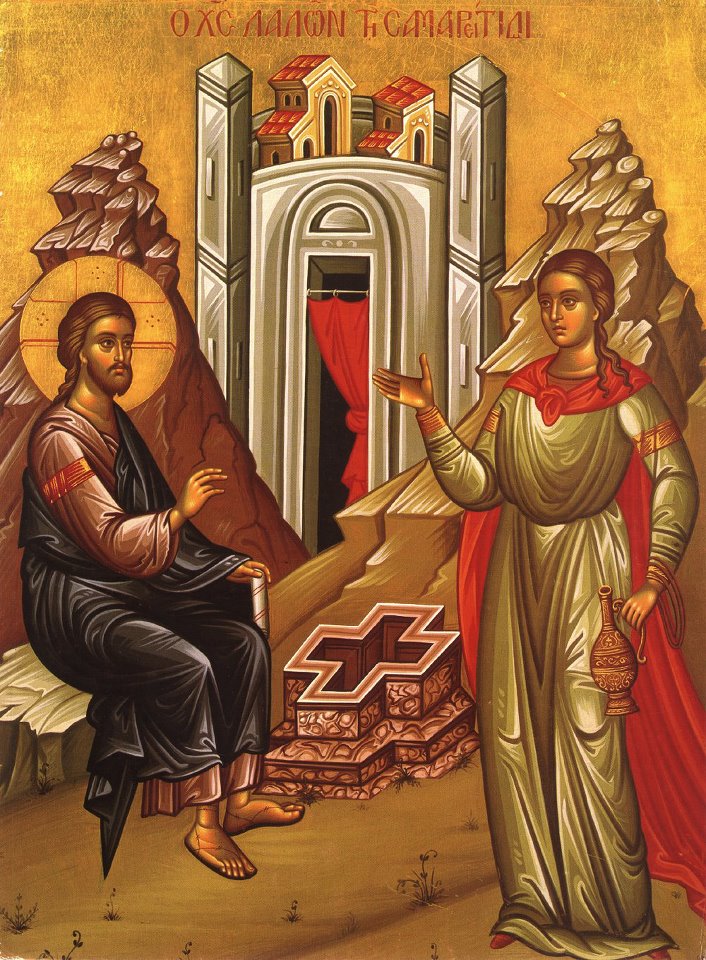Post-Easter Sundays
Saint Thomas Sunday: Antipascha
Every day during the week of Easter, called Bright Week by the Church, the paschal services are celebrated in all their splendor. The Easter baptismal procession is repeated daily. The royal gates of the sanctuary remain open. The joy of the Resurrection and the gift of the Kingdom of eternal life continue to abound. Then, at the end of the week, on Saturday evening, the second Sunday after Easter is celebrated in remembrance of the appearance of Christ to the Apostle Thomas “after eight days” (Jn 20.26).
It is important to note that the number eight has symbolical significance in both Jewish and Christian spiritual tradition. It signifies more than completion and fullness; it signifies the Kingdom of God and the life of the world to come since seven is the number of earthly time. The sabbath, the seventh day, is the blessed day of rest in this world, the final day of the week. The “first day of the week,” the day “after Sabbath”; stressed in all of the gospels as the day of Christ’s Resurrection (Mk 16.1, Mt 28.1, Lk 24.1, Jn 20.1, 19), is therefore also “the eighth day,” the day beyond the confines of this world, the day which stands for the life of the world to come, the day of the eternal rest of the Kingdom of God (see Heb 4).

The Sunday after Easter, called the Second Sunday, is thus the eighth day of the paschal celebration, the last day of Bright Week. It is therefore called the Antipascha, and it was only on this day in the early church that the newly-baptized Christians removed their robes and entered once again into the life of this world.
In the Church services the stress is on the Apostle Thomas’ vision of Christ and the significance of the day comes to us in the words of the gospel:
Then He said to Thomas, “Put your finger here, and see My hands; and put out your hand, and place it in My side; do not be faithless, but believing.” Thomas answered Him, “My Lord and my God!” Jesus said to him, “Have you believed because you have seen Me? Blessed are those who have not seen and yet believe” (Jn 20.27–29).
We have not seen Christ with our physical eyes nor touched His risen body with our physical hands, yet in the Holy Spirit we have seen and touched and tasted the Word of Life (1 Jn 1.1–4), and so we believe.
At each of the daily services until Ascension Day we sing the Easter Troparion. At each of the Sunday services beginning with Antipascha, we sing the Easter canon and hymns, and repeat the celebration of the “first day of the week” on which Christ rose from the dead. At all of the liturgies the epistle readings are taken from the Book of Acts telling us of the first Christians who lived in communion with the Risen Lord. All of the gospel readings are taken from the Gospel of Saint John, considered by many to be a gospel written particularly for those who are newly-baptized into the new life of the Kingdom of God through death and new birth in Christ, in the name of the Holy Trinity. The reason for this opinion is that all of the “signs”—as the miracles in Saint John’s Gospel are called—deal with sacramental themes involving water: wine and bread. Thus, each of the Sundays after Thomas Sunday with the exception of the third, is dedicated to the memory of one of these “signs.”
The Myrrhbearing Women

The third Sunday after Pascha is dedicated to the myrrhbearing women who cared for the body of the Saviour at his death and who were the first witnesses of His Resurrection. The three troparia of Holy Friday are sung once again and from the theme of the day:
The noble Joseph, when he had taken down Thy most pure body from the Tree, wrapped it in fine linen and anointed it with spices, and placed it in a new tomb.
When Thou didst descend to death, O Life Immortal, Thou didst slay hell with the splendor of Thy Godhead.
The angel came to the myrrhbearing women at the tomb and said: Myrrh is fitting for the dead, but Christ has shown Himself a stranger to corruption! So proclaim: The Lord is risen, granting the world great mercy.

The Paralytic
The fourth Sunday is dedicated to Christ’s healing of the paralytic (Jn 5). The man is healed by Christ while waiting to be put down into the pool of water. Through baptism in the church we, too, are healed and saved by Christ for eternal life. Thus, in the church, we are told, together with the paralytic, “to sin no more that nothing worse befall you” (Jn 5.14).
The Feast of Mid-Pentecost

In the middle of this fourth week, the middle day between Easter and Pentecost is solemnly celebrated. It is called the feast of Mid-Pentecost, at which Christ, “in the middle of the feast” teaches men of his saving mission and offers to all “the waters of immortality” (Jn 7.14). Again we are reminded of the Master’s presence and his saving promise: “If anyone is thirsty let him come to Me and drink” (Jn 7.37). We think also once again of our death and resurrection with Christ in our baptism, and our reception of the Holy Spirit from him in our chrismation. We “look back to one, and anticipate the other” as one of the hymns of the feast puts it. We know that we belong to that kingdom of the Risen Christ where “the Spirit and the Bride say, ‘Come!’ And let him who is thirsty come, let him who desires take the water of life without price” (Rev 22.17; Is 55.1).
In the middle of the feast, O Saviour, fill my thirsting soul with the waters of godliness, as Thou didst cry unto all: If anyone is thirsty, let him come to me and drink! O Christ God, Fountain of life, glory to Thee! (Troparion).
Christ God, the Creator and Master of all, cried to all in the midst of the feast of the law: Come and drink the water of immortality! We fall before Thee and faithfully cry: Grant us Thy bounties, for Thou art the Fountain of our life! (Kontakion).
The Samaritan Woman

The fifth Sunday after Easter deals with the woman of Samaria with whom Christ spoke at Jacob’s Well (Jn 4). Again the theme is the “living water” and the recognition of Jesus as God’s Messiah (Jn 4.10–11; 25–26). We are reminded of our new life in Him, of our own drinking of the “living water,” of our own true worship of God in the Christian messianic age “in Spirit and in Truth” (Jn 4.23–24). We see as well that salvation is offered to all: Jews and Gentiles, men and women, saints and sinners.
The Blind Man

The sixth Sunday commemorates the healing of the man blind from birth (Jn 9). We are identified with that man who came to see and to believe in Jesus as the Son of God. The Lord has anointed our eyes with his own divine hands and washed them with the waters of our baptism (Jn 9.6–11).
Jesus used clay of spittle and told the man to wash in the waters of Siloam. He did so because it was the Sabbath day on which spitting, clay-making and washing were strictly forbidden. By breaking these ritual laws of the Jews, Jesus showed that He is indeed the Lord of the Sabbath, and, as such, that He is equal to God the Father Who alone, according to Jewish tradition, works on the Sabbath day in running His world.
There is scandal over the healing of the blind man on the Sabbath day. He is separated from the synagogue because of his faith in Christ. The entire Church follows this man in his fate, knowing that it is those who do not see Jesus as the Lord who are really blind and still in their sins (Jn 9.41). The others have the light of life and can see and know the Son of God, for “you have seen Him, and it is He who speaks to you” (Jn 9.37).
I come to Thee, O Christ, blind from birth in my spiritual eyes, and call to Thee in repentance: Thou art the most radiant Light of those in darkness! (Kontakion).
